|
Everyone knows that
budgies come in many colours, almost all the ones found in a rainbow.
Yet do not understand what a certain pattern found on a bird means or
how it reacts to others. Here I hope to show you the basics of budgie
mutation so that future breeders can understand what is needed to get
that certain colour into their flock.
The first step is to
know the normal, which is a green budgerigar that is found in the wild
of Australia to this day.
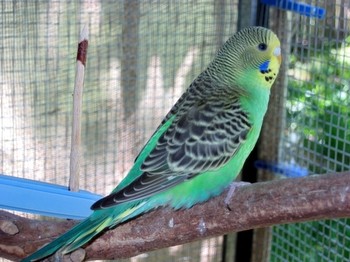 A
solid green body and a blue toned tail; Black bars that run down the
back of the neck to meet up with the wings. These are black with fine
yellow edging and bars and are called Ďshellí markings. This is what is
termed a green normal. This gene is dominant over everything. This is
where all the other colours you can see today spawned from. But donít
think this colour is now useless. A
solid green body and a blue toned tail; Black bars that run down the
back of the neck to meet up with the wings. These are black with fine
yellow edging and bars and are called Ďshellí markings. This is what is
termed a green normal. This gene is dominant over everything. This is
where all the other colours you can see today spawned from. But donít
think this colour is now useless.
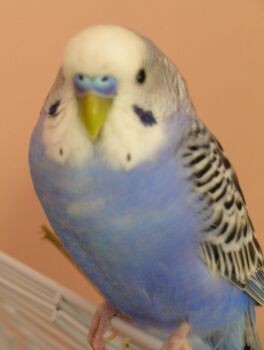
The first mutation
found is what is now called Blue, simply because that is what we see, a
blue bird. Yet the gene acts by removing the yellow tones from the
feathers rather than adding only blue.
This gene is
recessive, meaning it is hidden, by the green gene. A bird that looks
green can carry the blue gene and when matched in breeding to a blue
bird, blue young can be seen in the hatchlings. This is because both
parents give one gene each to the young ones, just like basic human
biology. If the green gene is give then the bird appears green, if the
blue gene is given matching with the other parents blue gene then the
blue looks blue.
|
X |
b |
b |
|
G (green) |
Gb |
Gb |
|
B (blue) |
bb |
bb |
A close and slightly
confusing mutation to the blue is the yellow face (YF) or Parblue gene.
This gives the blue bird a yellow face.. There are two types of this
yellow face gene, type 1 or type 2; known in Australia as golden face.
The type 1 has a clearly defined blue body and yellow face mask, while
the type 2 can get an all over body tone that looks like aqua or a
patchy bleed of yellow making some feathers in the body green. These
birds are still classed in the blue line because they are recessive to
the normal but the YF gene is dominant to the white face blue.
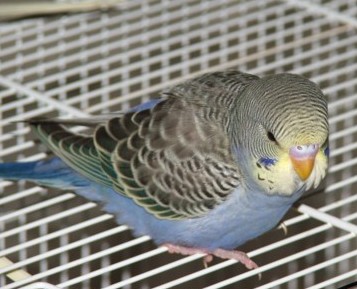
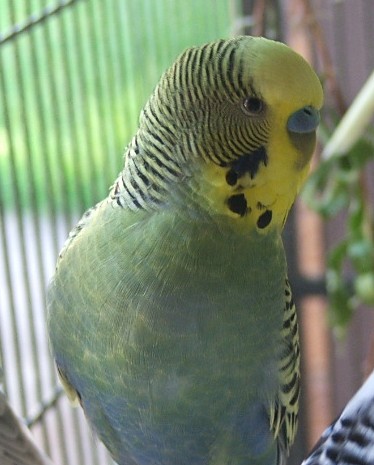
(type 1) (type2)
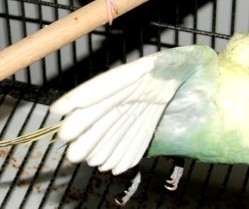
A type 2 yellow faces
can look like type 1 early in life, yet as they moult more and more
green will start to show up in their feathers, until you can have a bird
looking almost like a normal green. Then the clearest way to tell if you
have a yellow face bird is to look at the feathers under the wings,
these feathers stay the same as when young and are a sure sign that your
bird is a yellow face if they are blue instead of green. With this gene
you can also get a yellow face grey. More about grey below.
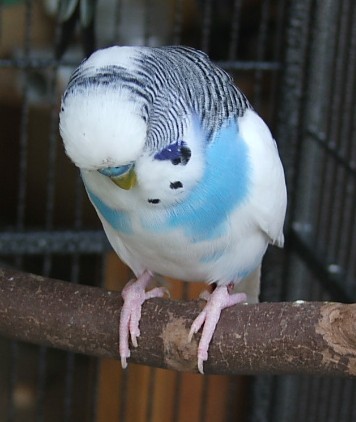
The most stunning and
dramatic genes that have been produced in budges is that of the pied.
Now many do not realised that there are in fact three (3) different
sorts of Pieds to be found, and that certain ones can be confused easily
one for the other. My favourite is the Australian Dominant Pied.
Clearly its name is simply to understand itís a pied form and is
dominant is heritage. You can get pied in all the colours, green and
yellow (green), blue and white(blue), blue and yellow(yf blue) and grey
and white(grey), even grey and yellow(yf grey).
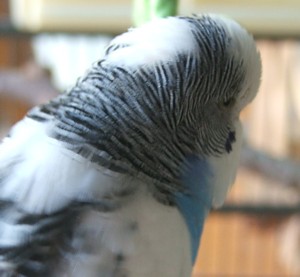 The
characteristic of a Dominant Pied is a clear head spot on the back of
the neck as pictured left and a clear band of colour (or lack of) across
the chest, this is why this type of mutation is also known as the banded
pied. The size and disputation of this Ďbandí is very wide spread and
is also affected if the bird is a double factor (df) or single factor (sf)
pied. With a double factor the colour is lessened and more spotted
which lead people to confuse it with a Recessive pied. (you will
understand more in a moment) The main feature that you can see on a
bird to class it as a dominant is the iris ring. This is the white band
that appears in the bird eye from around about the age after they first
moult (around 5 months) or sometime does not show clearly until the age
of one. The
characteristic of a Dominant Pied is a clear head spot on the back of
the neck as pictured left and a clear band of colour (or lack of) across
the chest, this is why this type of mutation is also known as the banded
pied. The size and disputation of this Ďbandí is very wide spread and
is also affected if the bird is a double factor (df) or single factor (sf)
pied. With a double factor the colour is lessened and more spotted
which lead people to confuse it with a Recessive pied. (you will
understand more in a moment) The main feature that you can see on a
bird to class it as a dominant is the iris ring. This is the white band
that appears in the bird eye from around about the age after they first
moult (around 5 months) or sometime does not show clearly until the age
of one.

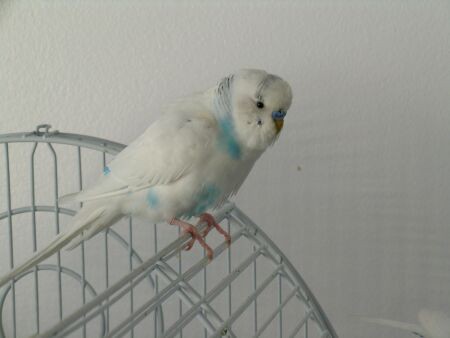 This
a double factor dominant pied, see how the marking are smaller than the
first one. When breeding this mutation there are no splits, if the baby
is given the gene by a parent it will show in the bird. So if you pair a
dominant Pied with a Normal you will get all pied. Pair a single factor
dominant with a normal and you will get 50% of each. This
a double factor dominant pied, see how the marking are smaller than the
first one. When breeding this mutation there are no splits, if the baby
is given the gene by a parent it will show in the bird. So if you pair a
dominant Pied with a Normal you will get all pied. Pair a single factor
dominant with a normal and you will get 50% of each.
The other dominant
pied is not talked about often and is the Dutch Dominant Pied. This
pied gene like the other dominant gene gets the iris ring. This pied
gets a lot more mottled look in the wings and more of a bleed like type
of colour from the neck to the chest. It can be confused with a
recessive because of the patterning of the colours but a Dutch dominant
tends to get more of the normal base body colour. Males of dominate
pieds get the deep blue cere.
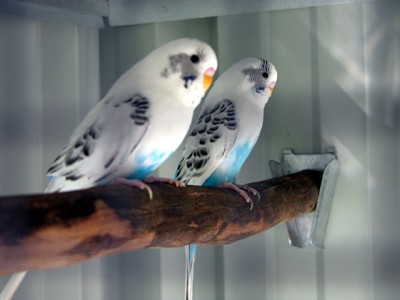 Recessive
Pied, Danish or Harlequin as they are sometime called in Australia, is
named just like the dominant ones because this gene is recessive. The
colouring of the type of pied is more varied than the other and is
mostly found around the belly area on the bird or on the rump between
the wings. The bars on the neck are patchy or missing and the wings
have a mottled look to them. Recessive
Pied, Danish or Harlequin as they are sometime called in Australia, is
named just like the dominant ones because this gene is recessive. The
colouring of the type of pied is more varied than the other and is
mostly found around the belly area on the bird or on the rump between
the wings. The bars on the neck are patchy or missing and the wings
have a mottled look to them.
One point to
remember is the iris ring; this doesnít appear in recessives like it
does in a dominant pied. Other slight factors in working out if your
bird is a recessive is not is to check for bright pink feet and bright
orange beak. But keep in mind these are not by far the one feature to
calculate this on.
A male recessive will
remain with a pinkie coloured cere of a young his whole life unlike
other mutations which get the normal deep blue for males. With breeding
you can get recessive from two normal looking parents for both genders
can hid this trait in their genes, meaning they can be split for it. To
get a recessive to appear you need two genes- one from each parent. This
means there are no sf recessive pied, because you need them to be df to
appear as a pied.
 A
very stunning mutation is Opaline. This gene affects the colouring of
the feather between the wings in a Ďví shape and the edging of the shell
markings, changing it to the body colour of the bird. This is a sex
linked gene meaning it is carried on the X chromosome. Now unlike
humans it is the male that has the XX while the female is the XY.
Because of this no female can be split for any sex-links genes (and
there are more than this one) Also with sex-linked traits it is easily
to get a female with the gene showing than a male. Because of the one x
chromosome if a hen is given the opaline gene then it will appear on the
bird. But if a male is only given one gene it remains hidden or split. A
very stunning mutation is Opaline. This gene affects the colouring of
the feather between the wings in a Ďví shape and the edging of the shell
markings, changing it to the body colour of the bird. This is a sex
linked gene meaning it is carried on the X chromosome. Now unlike
humans it is the male that has the XX while the female is the XY.
Because of this no female can be split for any sex-links genes (and
there are more than this one) Also with sex-linked traits it is easily
to get a female with the gene showing than a male. Because of the one x
chromosome if a hen is given the opaline gene then it will appear on the
bird. But if a male is only given one gene it remains hidden or split.
In breeding if you
have no parent with the opaline marking and find a young with them then
you know from that point on your male is split for this gene and that
hatchling is a female.
 One
that is very easily recognised is Ino ( Lutino and Albino), Pure yellow
and white budgies. Itís not hard to miss these with only one colour all
over their whole bodies, but there are some mutations that can look very
much alike. The one factor that pinpoints these bird as lutino or
Albino are the bright red eyes that they have from birth. This is
another sex linked gene so only males can be split for the gene and you
will find more females than males. No one gene can make an albino
budgie. To get a pure white bird you need a lutino or split lutino bird
paired with a blue one. The lutino gene will remove the grey and blue
colours from the bird while the blue gene will remove the yellow
colouring from the feathers leaving you with a white bird. The yellow
face gene can be used with ino to create a stunning looking bird known
as Yellow face Albino or more correctly termed Creamino. You get an
almost white bird with a strong yellow face mask and red eyes. One
that is very easily recognised is Ino ( Lutino and Albino), Pure yellow
and white budgies. Itís not hard to miss these with only one colour all
over their whole bodies, but there are some mutations that can look very
much alike. The one factor that pinpoints these bird as lutino or
Albino are the bright red eyes that they have from birth. This is
another sex linked gene so only males can be split for the gene and you
will find more females than males. No one gene can make an albino
budgie. To get a pure white bird you need a lutino or split lutino bird
paired with a blue one. The lutino gene will remove the grey and blue
colours from the bird while the blue gene will remove the yellow
colouring from the feathers leaving you with a white bird. The yellow
face gene can be used with ino to create a stunning looking bird known
as Yellow face Albino or more correctly termed Creamino. You get an
almost white bird with a strong yellow face mask and red eyes.
There are two
mutations that can be confused for these birds, that is the double
factor spangle (look below) and a Dark eyed clear. This is the outcome
of pairing a dominant pied with a recessive pied. This confusion is
easily made clear by taking note of the eye colour, only a ino will have
the red eye with a one coloured body, the others will have dark normal
eyes, no ring means DEC while an DF spangle has one.
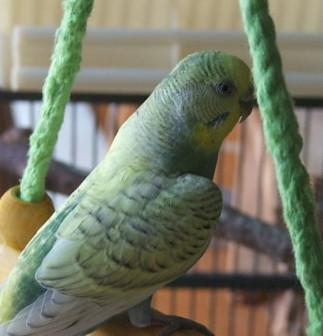 Another
mutation that affects the wing pattern is the Spangle. This seemed to
reverse the shell marking making the edges black. But looking closely
you can see the coloured edge still there; the gene actually reduces the
black of the wing to a fine line. This gene is a newish type having been
found in the 1970ís Another
mutation that affects the wing pattern is the Spangle. This seemed to
reverse the shell marking making the edges black. But looking closely
you can see the coloured edge still there; the gene actually reduces the
black of the wing to a fine line. This gene is a newish type having been
found in the 1970ís
This mutation is
dominant so again it means no bird can be split for this gene. Also
Single Factors and Double factor come into play again with this gene.
The one most people think of when talking of Spangles is the one
pictured to the left, which is the single factor bird, yet this gene
affects the feathers differently when a bird is a double factor. It
removes all colouring from the whole of the birdís body making it look
albino. Yet it still holds the dark eyes of a normal bird. These are
called black eyed clears.
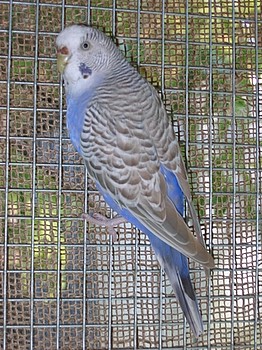
Cinnamon is a gene
that changes all the markings that you see on the wings and back of the
head from black to brown. This is another sex-linked gene, remember with
these types the males need two genes for them to appear as a cinnamon
and females only one and that only males can be split for this. It can
be confused with another type called fallow, more on that below. A bird
that is cinnamon will also have a paler body colour than others because
the black marking have been reduced to a brown.
The other brown tone
mutation is the fallow, this also give brown head bars and wing
markings, but this gene also give the bird a red eyes in the mature
bird. This mutation is recessive in inheritance unlike the cinnamon.
This means a bird must be double factor for it to appear in the feathers
and a budgie is split with only one gene for the mutation.
A very confusing
mutation is that of the dilute. This mutation as the name indicates
reduces the depth of colour in the feathers. But the confusing part is
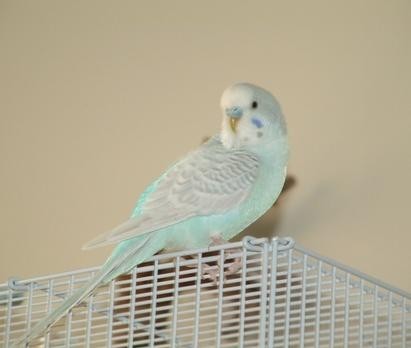 there
are three levels of dilution that can be found, all given different
names. The first level is called Grey wing. This gives the birdís
wings a grey tone rather than the normal black. The body colour should
not be diluted at all. there
are three levels of dilution that can be found, all given different
names. The first level is called Grey wing. This gives the birdís
wings a grey tone rather than the normal black. The body colour should
not be diluted at all.
The next step is
Clearwings. This level is also called yellowing in yellow base budgies
and whitewing in blue based budgies. Now the wing shell markings are a
pale grey colour. The aim is to get no markings on the wings but again
the body colour not affected by the dilution.
The final level is
called dilute, to add to the confusion of names for this mutation and is
where the whole bird, wings included, is pale in colour. To be dilute
the budgie must have dark eyes. This gene is recessive so sf bird does
not show the effects of the gene but carry it and if paired correctly
can past it on to their young.
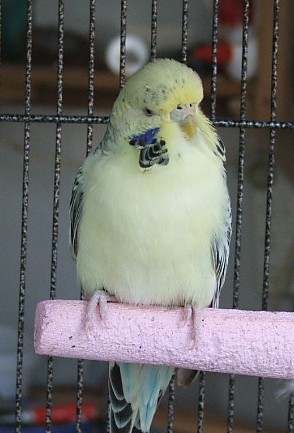 There
are two types of the clearbody gene, the first called Texas clearbody
and the other the Easley clearbody. This gene removed the colouring
from the feathers leaving a base colour, almost like the ino gene. But
this only affects the body of the bird not the wings. In a green based
bird it will have a yellow toned body and in a blue based bird will have
a white toned body. Also the flight feathers of the wing will be reduced
in colour making it almost like a grey wing. Both types are not easy
to tell apart, but the Easley removed the entire colour from the
feathers cells while the Texas only some, leaving a faint tone of green
to the bird. Both types are recessive meaning you need to genes to make
the bird show like a clearbody while with one gene they are split. There
are two types of the clearbody gene, the first called Texas clearbody
and the other the Easley clearbody. This gene removed the colouring
from the feathers leaving a base colour, almost like the ino gene. But
this only affects the body of the bird not the wings. In a green based
bird it will have a yellow toned body and in a blue based bird will have
a white toned body. Also the flight feathers of the wing will be reduced
in colour making it almost like a grey wing. Both types are not easy
to tell apart, but the Easley removed the entire colour from the
feathers cells while the Texas only some, leaving a faint tone of green
to the bird. Both types are recessive meaning you need to genes to make
the bird show like a clearbody while with one gene they are split.
There is a gene known
as the dark factor that turns the apple green colour of budgies into a
dark muddy tone or khaki and is called Olive. This had to do with a
dark factor which darkens the feathers of the bird. There can be single
or double bird in both the blue line and the green line. The normal
green has no dark factor and with a single factor the bird is a deeper
richer green, the Olive is the double factor bird in the green line. In
the blue line a sky blue has no dark factors, cobaltís have one and
Mauve (a greyish blue tone) has two.
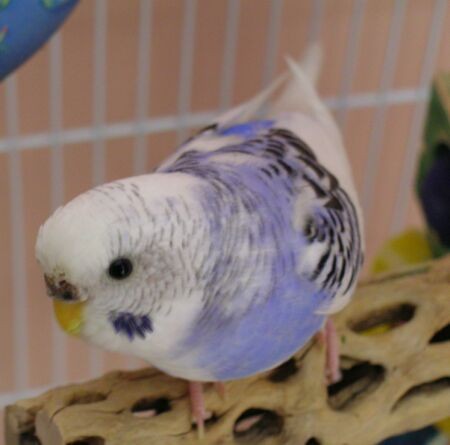 Violets
are easy to confuse with cobalt for the single factor bird looks almost
the same, points to look at are the cheek spots, they should be a very
deep and strong blue and darker, purple tints around the neck area. But
a double factor bird has a strong purple tone to its feathers and is
striking to look at. Also to keep in mine the sf violet can combine
with the green gene making a bird that looks similar to the olive. This
is a co dominant gene like the spangle, which means no bird can be split
for violet, but the sf bird look different to the df bird depending on
what other gene it was given by the parents, either a green or blue
gene. Violets
are easy to confuse with cobalt for the single factor bird looks almost
the same, points to look at are the cheek spots, they should be a very
deep and strong blue and darker, purple tints around the neck area. But
a double factor bird has a strong purple tone to its feathers and is
striking to look at. Also to keep in mine the sf violet can combine
with the green gene making a bird that looks similar to the olive. This
is a co dominant gene like the spangle, which means no bird can be split
for violet, but the sf bird look different to the df bird depending on
what other gene it was given by the parents, either a green or blue
gene.

Grey is a dominant
mutation which means you can have both single factor bird and double
factor bird. Simply looking at the bird can not tell you which one it
is. Only by breeding would you find out, a df factor bird will produce
only greys while a sf bird will have some greys and some others. It is
not sex-linked and so doesnít matter which parent is grey. The visual
grey is the joining of grey and blue almost like the ino gene to make
albino. A bird with a grey gene and yellow gene appears grey-green
similar to the olive colouring. This gene stops the other colours from
showing, and allows the base colour to show through.
There is a very rare
mutation that adds more black lines around the face of the bird, hence
the name- black face or more correctly termed Melanistic. These bars do
not fade like the baby bars on normal budgies. It also adds more grey
(black) pigment to the whole of the body giving a dark body colour. It
is recessive in breeding which mean both parents need the gene to pass
on to the chick. These are so hard to come by that you would have won
the lottery in budgies to have one.
Written by Nerwen, Pictures given with permision from owners on
BudgieBreeders forum.
|

